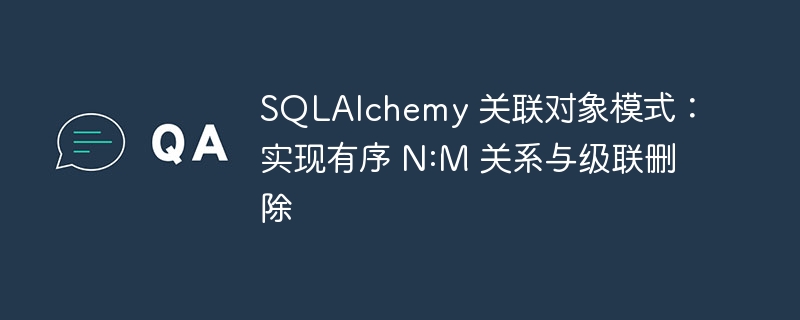SQLAlchemyN:M关系与级联删除实现方法
时间:2025-08-14 23:48:30 399浏览 收藏
最近发现不少小伙伴都对文章很感兴趣,所以今天继续给大家介绍文章相关的知识,本文《SQLAlchemy 有序N:M关系与级联删除实现》主要内容涉及到等等知识点,希望能帮到你!当然如果阅读本文时存在不同想法,可以在评论中表达,但是请勿使用过激的措辞~

1. 理解问题背景与初始尝试
在数据库设计中,处理“文件夹包含项目”这类关系时,常常需要维护项目在文件夹中的特定顺序。最初,开发者可能倾向于采用简单的“一对多”(1:M)关系,并在父对象(Folder)中存储一个列表(例如 ARRAY(String))来记录项目ID的顺序。
class Folder(Base):
__tablename__ = "folder"
id = Column(Integer, primary_key=True)
items = relationship(
"Item",
back_populates="folder",
cascade="all, delete-orphan",
)
item_ordering = Column(ARRAY(String), default=[]) # 存储顺序的列表
class Item(Base):
__tablename__ = "item"
id = Column(Integer, primary_key=True)
folder_id = Column(String, ForeignKey("folder.id", ondelete="CASCADE"))
folder = relationship("Folder", back_populates="items")这种方法虽然直观,但存在一个显著的缺点:item_ordering 列表中的ID可能与实际 Folder 中 Item 对象的集合不一致,导致数据冗余和潜在的同步问题。为了提高健壮性并支持更复杂的 N:M 关系(即使在这个场景中,一个 Item 最终只属于一个 Folder,但通过关联对象可以更好地管理顺序),引入了 SQLAlchemy 的关联对象模式。
2. 关联对象模式与级联删除的挑战
关联对象模式通过引入一个中间表(即关联对象)来管理两个实体之间的关系,并允许在该中间表中存储额外的数据,例如本例中的 order 字段。
# 关联对象定义
class FolderItemAssociation(Base):
__tablename__ = "folder_item_association"
project_id = Column(Integer, ForeignKey("folder.id", ondelete="CASCADE"), primary_key=True)
item_id = Column(Integer, ForeignKey("item.id", ondelete="CASCADE"), primary_key=True, unique=True)
order = Column(BigInteger, autoincrement=True) # 存储顺序
folder = relationship("Folder", back_populates="item_associations")
item = relationship("Item", back_populates="folder_association")
# Folder 和 Item 的修改
class Folder(Base):
__tablename__ = "folder"
id = Column(Integer, primary_key=True)
item_associations = relationship(
"FolderItemAssociation",
back_populates="folder",
order_by="desc(FolderItemAssociation.order)",
single_parent=True,
cascade="all, delete-orphan",
)
class Item(Base):
__tablename__ = "item"
id = Column(Integer, primary_key=True)
folder_association = relationship(
"FolderItemAssociation",
back_populates="item",
passive_deletes=True,
uselist=False,
)在这种设置下,当删除一个 Folder 对象时,预期行为是:
- Folder 对象被删除。
- 与该 Folder 关联的所有 FolderItemAssociation 记录被删除。
- 与这些 FolderItemAssociation 记录关联的 Item 对象也应被删除(因为它们被视为该 Folder 的“孤立”子项)。
然而,实际测试发现,虽然 Folder 和 FolderItemAssociation 记录被删除,Item 对象却仍然存在于数据库中,成为了“孤立项”。这表明级联删除并未完全生效。
3. 级联删除原理与 single_parent 参数
SQLAlchemy 的级联删除行为由 relationship 上的 cascade 参数控制。cascade="all, delete-orphan" 意味着当父对象被删除时,其关联的子对象也会被删除。其中 delete-orphan 选项特别重要,它指示 SQLAlchemy 跟踪子对象的“父级”状态。如果一个子对象不再与任何父对象关联,且其父关系被标记为 single_parent=True,则该子对象将被视为孤立并被删除。
在这个特定的关联对象模式中,Folder 通过 item_associations 关系级联删除了 FolderItemAssociation 实例。问题在于,当 FolderItemAssociation 实例被删除时,它并没有将关联的 Item 实例视为其“孤立”子项并触发删除。这是因为 FolderItemAssociation.item 关系缺少了必要的 cascade 和 single_parent 配置。
4. 解决方案与代码实现
要解决 Item 对象未被级联删除的问题,核心在于明确 FolderItemAssociation 对其关联 Item 的所有权。这意味着在 FolderItemAssociation 类中,指向 Item 的 relationship 应该配置 cascade="all, delete-orphan" 和 single_parent=True。
from sqlalchemy import create_engine, Integer, String, BigInteger, Column, ForeignKey
from sqlalchemy.orm import declarative_base, Session, relationship
Base = declarative_base()
class Folder(Base):
__tablename__ = "folder"
id = Column(Integer, primary_key=True)
# Folder 通过 item_associations 关系管理 FolderItemAssociation 实例
# 当 Folder 删除时,其关联的 FolderItemAssociation 实例也会被删除
item_associations = relationship(
"FolderItemAssociation",
back_populates="folder",
order_by="desc(FolderItemAssociation.order)",
single_parent=True, # 确保 Folder 是 FolderItemAssociation 的唯一父级
cascade="all, delete-orphan", # 级联删除 FolderItemAssociation
)
def __repr__(self):
return f"Folder(id={self.id}, item_associations={', '.join(repr(assoc) for assoc in self.item_associations)})"
class FolderItemAssociation(Base):
__tablename__ = "folder_item_association"
project_id = Column(Integer, ForeignKey("folder.id", ondelete="CASCADE"), primary_key=True)
item_id = Column(Integer, ForeignKey("item.id", ondelete="CASCADE"), primary_key=True, unique=True)
order = Column(BigInteger) # autoincrement 可能因数据库而异,此处简化
folder = relationship(
"Folder",
back_populates="item_associations",
)
item = relationship(
"Item",
back_populates="folder_association",
# --- 关键修改 ---
# 当 FolderItemAssociation 被删除时,如果 Item 成为孤立,则删除 Item
cascade="all, delete-orphan",
single_parent=True # 确保 FolderItemAssociation 是 Item 在此上下文中的唯一父级
)
def __repr__(self):
return f"Assoc(id={(self.project_id, self.item_id)}, order={self.order}, item={repr(self.item)})"
class Item(Base):
__tablename__ = "item"
id = Column(Integer, primary_key=True)
folder_association = relationship(
"FolderItemAssociation",
back_populates="item",
passive_deletes=True, # 优化删除性能,避免在删除前加载关联对象
uselist=False, # 表示 Item 只有一个 FolderItemAssociation
)
def __repr__(self):
return f"Item(id={self.id})"
# 数据库连接和表创建 (示例使用 SQLite)
engine = create_engine("sqlite:///:memory:", echo=False)
Base.metadata.create_all(engine)
# 辅助函数
def get_counts(session):
return (
session.query(Folder).count(),
session.query(FolderItemAssociation).count(),
session.query(Item).count(),
)
def assert_counts(session, expected_counts):
counts = get_counts(session)
assert counts == expected_counts, f'Expected {expected_counts} but got {counts}'
def reset(session):
session.query(Folder).delete()
session.query(FolderItemAssociation).delete()
session.query(Item).delete()
session.commit()
assert_counts(session, (0, 0, 0))
def create_sample_folders(session):
folder1 = Folder(
id=1,
item_associations=[
FolderItemAssociation(item=Item(id=101)),
FolderItemAssociation(item=Item(id=102))
]
)
session.add(folder1)
folder2 = Folder(
id=2,
item_associations=[
FolderItemAssociation(item=Item(id=201)),
FolderItemAssociation(item=Item(id=202))
]
)
session.add(folder2)
session.commit()
### 5. 验证级联删除行为
以下测试用例将验证修改后的模型是否正确实现了级联删除:
```python
def test_folder_deletion_cascades_to_items():
""" 验证删除 Folder 时,关联的 Item 是否被删除。"""
with Session(engine) as session:
reset(session)
create_sample_folders(session)
assert_counts(session, (2, 4, 4)) # 2个Folder, 4个Association, 4个Item
# 删除第一个 Folder
folder_to_delete = session.query(Folder).filter_by(id=1).first()
session.delete(folder_to_delete)
session.commit()
# 预期:剩余1个Folder, 2个Association, 2个Item
assert_counts(session, (1, 2, 2))
print(f"Test 1 (Folder deletion): Counts after delete: {get_counts(session)}")
reset(session)
def test_item_deletion_does_not_delete_folder():
""" 验证删除 Item 时,Folder 不被删除。"""
with Session(engine) as session:
reset(session)
create_sample_folders(session)
assert_counts(session, (2, 4, 4))
# 删除一个 Item
item_to_delete = session.query(Item).filter_by(id=101).first()
session.delete(item_to_delete)
session.commit()
# 预期:2个Folder, 3个Association, 3个Item (因为一个Item和它的Association被删除了)
assert_counts(session, (2, 3, 3))
print(f"Test 2 (Item deletion): Counts after delete: {get_counts(session)}")
reset(session)
def test_association_deletion_cascades_to_item():
""" 验证删除 Association 时,关联的 Item 是否被删除。"""
with Session(engine) as session:
reset(session)
create_sample_folders(session)
assert_counts(session, (2, 4, 4))
# 删除一个 FolderItemAssociation
assoc_to_delete = session.query(FolderItemAssociation).first()
session.delete(assoc_to_delete)
session.commit()
# 预期:2个Folder, 3个Association, 3个Item (因为一个Association和它的Item被删除了)
assert_counts(session, (2, 3, 3))
print(f"Test 3 (Association deletion): Counts after delete: {get_counts(session)}")
reset(session)
# 运行测试
test_folder_deletion_cascades_to_items()
test_item_deletion_does_not_delete_folder()
test_association_deletion_cascades_to_item()6. 总结与注意事项
通过上述修改,我们成功地在 SQLAlchemy 的关联对象模式中实现了预期的级联删除行为。核心要点在于:
- 明确所有权: 当使用 delete-orphan 级联时,必须清楚地定义哪个对象是其关联对象的“父级”。在这个例子中,FolderItemAssociation 被定义为 Item 的父级,从而允许当 FolderItemAssociation 被删除时,其关联的 Item 也被删除。
- single_parent=True 的作用: 这个参数与 delete-orphan 紧密配合,它告诉 SQLAlchemy,这个关系中的子对象只能有一个“父级”。当这个唯一的父级被删除或子对象从该关系中解除关联时,子对象就被视为孤立并符合删除条件。
- 多重关系处理: 在原始问题中,Folder 类同时定义了 items(使用 secondary)和 item_associations 两个关系。在实际应用中,同时维护这两种访问方式可能会导致混淆或不一致。如果 item_associations 提供了所需的所有功能(包括顺序),可以考虑将 items 关系标记为 viewonly=True,或者直接移除它以简化模型。
- autoincrement 在 order 列上的行为: BigInteger 类型的 order 列使用 autoincrement=True 在某些数据库(如 PostgreSQL)中可能不会自动填充值,因为它通常与 SERIAL 或 IDENTITY 类型一起使用。对于需要自动递增的顺序值,更稳健的方法是使用数据库的序列(Sequence)或在应用程序层面手动管理顺序(例如,在添加新项目时计算最大顺序值加一)。
通过深入理解 cascade 和 single_parent 参数的机制,开发者可以在 SQLAlchemy 中构建更复杂、更健壮的数据模型,有效管理对象生命周期和数据完整性。
到这里,我们也就讲完了《SQLAlchemyN:M关系与级联删除实现方法》的内容了。个人认为,基础知识的学习和巩固,是为了更好的将其运用到项目中,欢迎关注golang学习网公众号,带你了解更多关于的知识点!
-
501 收藏
-
501 收藏
-
501 收藏
-
501 收藏
-
501 收藏
-
106 收藏
-
227 收藏
-
168 收藏
-
458 收藏
-
142 收藏
-
259 收藏
-
113 收藏
-
327 收藏
-
358 收藏
-
340 收藏
-
365 收藏
-
391 收藏
-

- 前端进阶之JavaScript设计模式
- 设计模式是开发人员在软件开发过程中面临一般问题时的解决方案,代表了最佳的实践。本课程的主打内容包括JS常见设计模式以及具体应用场景,打造一站式知识长龙服务,适合有JS基础的同学学习。
- 立即学习 543次学习
-

- GO语言核心编程课程
- 本课程采用真实案例,全面具体可落地,从理论到实践,一步一步将GO核心编程技术、编程思想、底层实现融会贯通,使学习者贴近时代脉搏,做IT互联网时代的弄潮儿。
- 立即学习 516次学习
-

- 简单聊聊mysql8与网络通信
- 如有问题加微信:Le-studyg;在课程中,我们将首先介绍MySQL8的新特性,包括性能优化、安全增强、新数据类型等,帮助学生快速熟悉MySQL8的最新功能。接着,我们将深入解析MySQL的网络通信机制,包括协议、连接管理、数据传输等,让
- 立即学习 500次学习
-

- JavaScript正则表达式基础与实战
- 在任何一门编程语言中,正则表达式,都是一项重要的知识,它提供了高效的字符串匹配与捕获机制,可以极大的简化程序设计。
- 立即学习 487次学习
-

- 从零制作响应式网站—Grid布局
- 本系列教程将展示从零制作一个假想的网络科技公司官网,分为导航,轮播,关于我们,成功案例,服务流程,团队介绍,数据部分,公司动态,底部信息等内容区块。网站整体采用CSSGrid布局,支持响应式,有流畅过渡和展现动画。
- 立即学习 485次学习
